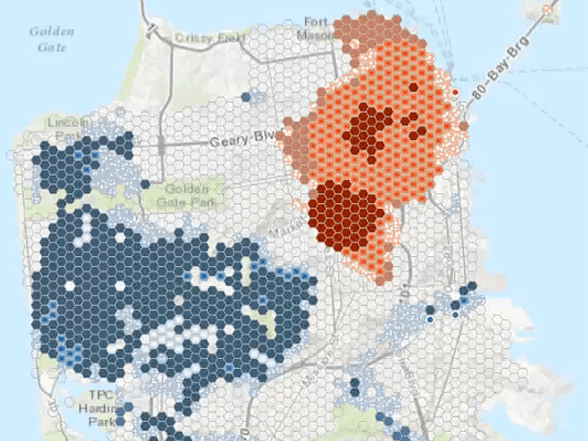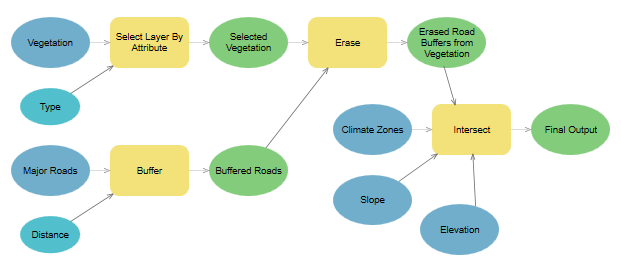Spatial analysis allows you to solve complex location-oriented problems, find patterns, assess trends and make decisions.. Spatial analysis goes beyond mapping and allows you to study the characteristics of places and the relationships among them. Spatial analysis lends new perspectives to your decision making.
Using spatial analysis, you can combine information from many sources and derive new information by applying a set of spatial operators. This collection of spatial analysis tools allows you to answer complex spatial questions. Statistical analysis can determine if the patterns that you see are significant. You can analyze various layers to calculate the suitability of a place for a particular activity and, using image analysis, you can detect change over time. These tools allow you to address important questions and decisions that are beyond the scope of simple visual analysis.

You can do the following using spatial analysis:
- Determine relationships.
- Understand and describe locations and events.
- Detect and quantify patterns.
- Make predictions.
- Find best locations and paths.
You can use the analysis and geoprocessing capabilities in ArcGIS Pro to answer many spatial questions and perform spatial analysis. To perform spatial analysis, first frame your question. Then prepare and analyze your data. Finally, visualize and communicate your results. Spatial analysis in ArcGIS Pro is extended from 2D to 3D and through time.
Spatial analysis
Using geoprocessing tools in ArcGIS Pro, you can perform the following types of operations on geographic data:
- Extract and overlay data.
- Add and calculate attribute fields.
- Summarize and aggregate data.
- Calculate statistics.
- Model relationships and discover patterns.
Modeling and scripting
Save time on repetitive tasks, minimize errors, and iterate on your analysis more efficiently. Create end-to-end workflows by chaining models and spatial algorithms together into a single process. Build fully functional models without a line of script using ModelBuilder, or use Python to script your workflows and create ready-to-share models.

If ArcGIS Pro does not include a tool that answers your specific question, you can build a custom tool. Add additional third-party libraries to ArcGIS Pro using the Python Package Manager.
Visualization with charts
Visualizing data using charts can uncover data patterns, trends, relationships, and structures that may otherwise be difficult to see as raw numbers in a table. Interpret the results of your analysis and communicate the findings with charts.

Analysis extensions
ArcGIS Pro includes the following analysis extensions to help you answer specialized spatial questions:
- 3D Analyst—Analyze and create 3D GIS data and perform 3D surface operations using rasters, TINs, terrains, and LAS datasets (lidar).
- Business Analyst—Analyze market trends, including customer and competitor analysis, site evaluation, and territory planning.
- Geostatistical Analyst—Analyze and predict the values associated with spatial or spatiotemporal phenomena.
- Image Analyst—Interpret and exploit imagery, perform feature extraction and measurement, and perform classification and object detection using machine learning.
- Network Analyst—Measure distances and travel times along a network to find a route between multiple locations, create drive-time buffers or service areas, and find the best locations for facilities to serve a set of locations.
- Spatial Analyst—Perform interpolation, overlay, distance measurement, density, hydrology modeling, site suitability, and math and statistics on cell-based raster data.
Sharing and collaboration
You can share the analysis methodology as well as the data you have analyzed in ArcGIS Pro with your colleagues, organization, or community as geoprocessing packages or web tools. With these shared analysis tools, anyone can leverage your expertise in spatial analysis while performing the analysis themselves.
Big data analytics
A big data connection (BDC) allows you to quickly connect to data sources to visualize and analyze large datasets. A BDC provides functionality and flexibility to work with your data and its formatting. You can use BDC datasets as input to geoprocessing tools and visualize the data on a map
Machine learning and artificial intelligence
You can use machine learning in ArcGIS to perform image classification, enrich data with clustering, and model spatial relationships. Machine learning is a branch of artificial intelligence in which structured data is processed with an algorithm to solve a problem. Traditional structured data requires a person to label the data, such as a pictures of cats and dogs, so that specific features for each animal type can be understood in the algorithm and used to identify the animals in other pictures.